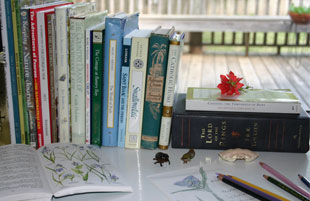| Author | |
Sarah M
Forum All-Star

Joined: Jan 06 2008
Location: Washington
Online Status: Offline
Posts: 1423
|
| Posted: Nov 10 2008 at 4:01pm | IP Logged
|
 |
|
We are just now really diving into history, and my question is: how do you know that whatever you are reading is a trustworthy source? For example, we are starting with American History, and I recently picked up The American Story by Jennifer Armstrong, thinking it looks like a "real book" and "living history" with lots of nice pictures in it. But then when I flipped around a bit, I noticed that a couple of modern stories (most obviously the 2000 Election) were rather biased. I only know that because I was there, but what about stories from long ago?
The public schools I attended as a child replaced History with "Social Studies," and as such, I don't have much historical knowledge to start with! So when I google something like "who discovered America", and I get 7 different answers, I start to get a little  . .
How do you know, when you pick up a book, that you can trust what the authors say?
|
| Back to Top |


|
| |
Sarah M
Forum All-Star

Joined: Jan 06 2008
Location: Washington
Online Status: Offline
Posts: 1423
|
| Posted: Nov 11 2008 at 6:50pm | IP Logged
|
 |
|
Bump. 
|
| Back to Top |


|
| |
Mackfam
Board Moderator


Non Nobis
Joined: April 24 2006
Location: Alabama
Online Status: Offline
Posts: 14656
|
| Posted: Nov 12 2008 at 8:02am | IP Logged
|
 |
|
Sarah,
I think it just takes some digging.
First, I look to the publisher. I don't really use textbooks at all unless maybe as a sort of spine for me or for reference. Most of our history studies come from living books which on the whole I find much more balanced and real anyway.
Let's take your example of who discovered America. I like the texts recently published by the Catholic Textbook Project. I might start there with the discovery of America. From there, I build a library list of living books which generally provides a nice bit of balance to the text. Googling further provides even more information if I'm feeling an approach is one sided, politically correct or inaccurate. From there, I can generally piece together enough information to provide some balance for our discussions.
With younger students I don't provide nearly the level of information or detail, but I still dig for myself so I can answer questions. So, for example you might just say that the new world was a wide open space and many men had a hand in its first exploration. Christopher Columbus is generally agreed upon as the discoverer of America (though we know she was already "discovered" by many Native Americans), and the name America is derived from another first explorer, Amerigo Vespucci. Another approach would be to get organized and introduce a map of America first and attach it to your timeline. Then, in order of first explorers first starting with the Vikings, timeline and chronicle the different explorers and inhabitants maybe going into a little detail and background on each and pointing out the significant explorers - Columbus and Vespucci. You map their point of discovery as you go. In this way over the years all the little bits of information and books the children read start to connect and gel and they will get a sense of balance from their own studies.
I know it seems like a lot of work, but it has been edifying for me. You sort of get into a groove as you go along. I had the same bland, watered down public school education in social studies that you did - so I'm learning right alongside my kids!
HTH! 
__________________
Jen Mackintosh
Wife to Rob, mom to dd 19 , ds 16 , ds 16 , ds 11 , ds 11 , dd 8 , dd 8 , and dd 3 , and dd 3
Wildflowers and Marbles
|
| Back to Top |



|
| |
Rachel May
Forum All-Star

Joined: June 24 2005
Location: Kansas
Online Status: Offline
Posts: 2057
|
| Posted: Nov 12 2008 at 2:04pm | IP Logged
|
 |
|
I usually start by buying the books suggested by someone I think is smart and trustworthy--like Elizabeth's booklist or Laura Berquist's suggestions for example.
OT, here is an interesting tidbit on the discovery of America that I recently found out:
"In 1976, Irish explorer Tim Severin built an ox-leather curragh and over two summers sailed her from Ireland via the Hebrides, Faroe Islands and Iceland to Newfoundland in an attempt to demonstrate that it was feasible for Brendan to have reached America. On his voyage, he encountered various sights such as icebergs and sea animals such as whales and porpoises which he suggests are factual counterparts to the fantastic sights from the legends of Brendan.[8]"
That's from wikipedia--not a good source, but we originally read about St. Brendan in
The Catholics Faith Comes to the Americas. 
__________________
Rachel
Thomas and Anthony (10), Maria (8), Charles (6), Cecilia (5), James (3), and Joseph (1)
|
| Back to Top |


|
| |
|
|


 Topic: How do you know it's a good source?
Topic: How do you know it's a good source?


 .
.




 , ds 16
, ds 16